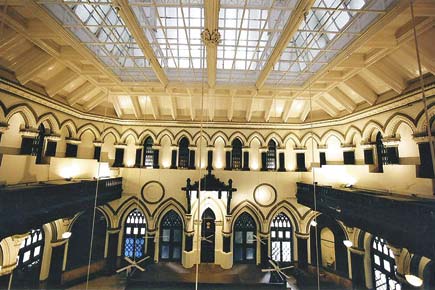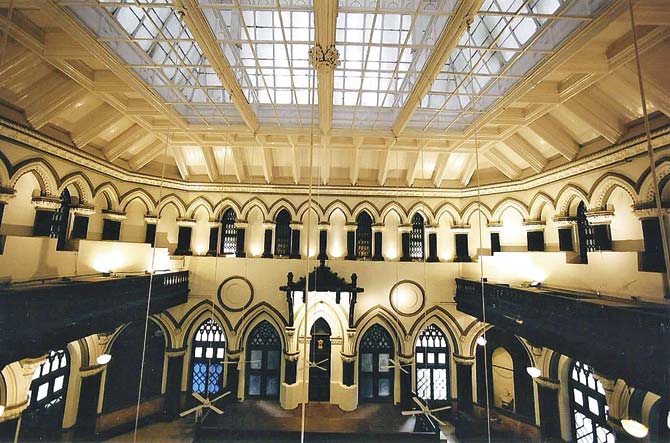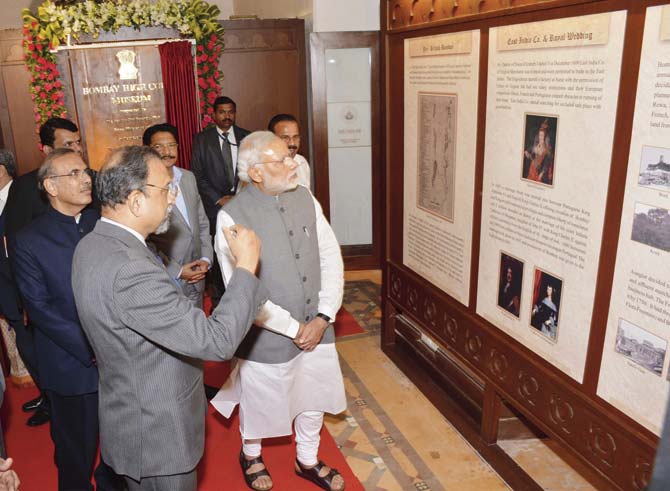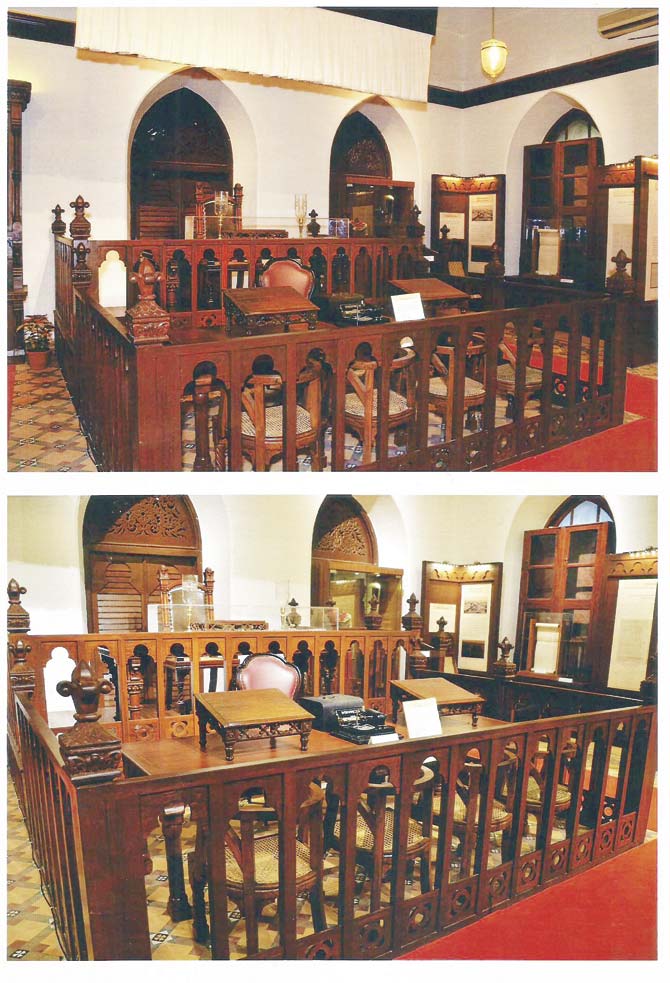The newly-opened Bombay High Court museum is a must-visit for anyone who wishes to understand how the city’s legal system took form and shape

After a long while, an engaging city heritage tour caught our attention. This was the Bombay High Court tour conducted by veteran solicitor Rajan Jayakar, and organised by INTACH. After all, not often does one get the chance to step into a landmark that has always piqued the imagination in terms of how it shaped the city in countless ways, for centuries together.

Gothic columns with stunning carvings add to the splendour of Court Room No 46. Pic courtesy/Kakubhai Kothari
ADVERTISEMENT
Jayakar, considered as one of India’s finest collectors of souvenirs and memorabilia, was also the brain behind the setting up of The Bombay High Court Museum, our first stop on the tour. Prime Minister Narendra Modi opened the museum to the public on February 14, this year.

Rajan Jayakar (l) with Prime Minister Narendra Modi at the museum’s opening. Pics courtesy/Indian Art Studio
Located on the ground floor, it boasts of classic, subtly-lit interiors and offers easy-to-process information on wood panelled boards that lined its walls. Our two-hour history lesson took us through a timeline that dated back to the 12-13 centuries when the traces of the first legal system were found in Parel, during Raja Bimb’s rule.

A replica of a courtroom from the early 1900s
Jayakar, with his crisp narrative, peppered with anecdotes and trivia, made it engaging for not just the law-leaning individual. We noticed how the first sections also make for an insightful introduction for any visitor to learn about history of the city.
“Bombay was not important to early rulers. In the 1600s, the nearest high court was in Bassein and if one had to appeal further, they would have to go to Goa,” revealed Jayakar amidst smiles and chuckles in the group.
As the centuries rolled over, the group moved on to how the city changed hands; we were staring at the 17th century, when Gerald Aungier, second Governor-General of the East India Company, set up the first formalized court of law on August 8, 1672 near the old Custom House.
“After Aungier’s death in 1677, justice took a beating in the city, and there was lawlessness,” shared Jayakar. The group was introduced to important points in history when various courts of justice like the Mayor’s Court (1726) and Recorder’s Court (1798) were set up.
A dual system of attorneys and barristers was in practice at that time, and goldmohurs from Surat became the accepted form of money for them (mostly British). “In 1824, the Supreme Court decided that Bombay needed a separate judicial system because like Calcutta and Madras, Bombay too developed into a presidency,” informed Jayakar while many within the group had to keep a furious pace while taking notes.
An hour had passed already, and we moved into the 1800s, when the Admiralty House building became the seat of the Bombay High Court (1862-78). “The new building, where we stand now, was designed by JA Fuller. Work began in 1871 and was completed in 1878. This land was probably once the water moat around the long-gone Fort walls,” revealed Jayakar, as we all lapped up the trivia.
At the centre of the museum, we gathered around a life-size model of a courtroom, complete with Burma teak furniture, cloth fans, the judge’s seat and other memorabilia. Soon, we were taken to a section that celebrated national leaders and luminaries who were associated with the Bombay High Court including Mahatma Gandhi, Dr B R Ambedkar, Lokmanya Tilak and judicial stalwarts like Dinshaw Mulla and M K Jayakar.
Next, we headed upstairs, to Court Room No 46, our second and final stop. Along the way, we noticed how the capitals in along the corridors displayed fascinating carvings of birds and animals. “On August 14, 1947, Sir Leonard Stone, the last British Chief Justice of the Bombay HC handed over the baton to the first Indian counterpart, Mahomedali Chagla inside this Court Room No 46, and said a prayer for the new country.
Then, at 12 midnight, the tricolour was unfurled inside the courtroom as shouts of Jai Hind! All assembled sang Vande Mataram (*Jana Gana Mana was adopted as the National Anthem of India on January 24, 1950) Rajabai Tower chimed in all her magnificent glory, as fireworks and celebrations took over Mumbai (then Bombay),” revealed Jayakar as the group gasped at this fabulous room that is arguably the centrepiece of the structure, with a jaw-dropping 120-feet high ceiling.
Around us, we noticed faces of people from different communities (they wore different turbans) and animals carved on the capital columns; both references, we were told, were commonly seen in the Bombay Presidency. The story behind how the grand chandelier in the centre was restored made for a fascinating story by Jayakar.
After 120 minutes inside this hallowed landmark, seated on the wooden chairs, we couldn’t help but imagine a court scene right there that might have featured the likes of greats like Lokmanya Tilak or Dinshaw Mulla.
May justice prevail!
 Subscribe today by clicking the link and stay updated with the latest news!" Click here!
Subscribe today by clicking the link and stay updated with the latest news!" Click here!







